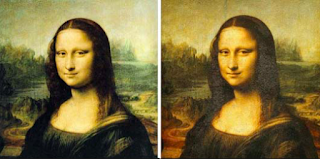Event 5- African Print Fashion Now!
This
exhibit was at the Fowler Museum on UCLA’s campus and it was speaking my kind
of language. It was a room full of fashion, color and clothes. These were not
your average clothes. They were very extravagant with unique patterns and very colorful.
These bold clothes are home to Africa fashion. While the clothes themselves
were made in Europe, the design stays true to its roots. Different countries in
Africa have different styles, but each piece of clothing is made my hand and
personalized. These African ensembles consist of wrap skirts, head dresses,
ruffles, jewelry, handbags and shoes. African fashion has always been very
distinct but in the past decade it has gone international. Many African fashion
designers are bringing their bright colors and bold design to runways all over
the world.
(Courtesy of: Jordan Anderson) (Courtesy of: Jordan Anderson)
Each culture and nation had a
different twist on their clothing. Each piece of clothing has a story behind it
whether it is a “narrative of self-expression, stories of family and history,
or images of cutting edge global chic.” While each piece of clothing is unique,
each country has two different basic styles. The first is a 20th century
three-piece ensemble consisting of a long wrap skirt, top and scarf. The second
style is a more modern style consisting of dresses, jackets and pants.
(Courtesy of: Jordan Anderson) (Courtesy of: Jordan Anderson)
In Nigeria, the Yoruba, Igbo, and
Hausa women have similar styles and are known for their cotton print to create
their ensemble of a rap skirt and a top. Nigerians have worn this style for
many years and have not shied away from it. The only time they wear a different
pattern or style of clothing is when they attend a wedding.
(Courtesy of: Jordan Anderson) (Courtesy of: Jordan Anderson)
In Cameroon, the clothing there is
more global. While you can find may traditional patterns in marketplaces across
Cameroon, seamstresses have begun to reach out to social media for inspiration.
They want to create a trendier style of African ensembles. The busiest time of
the year for Cameroon seamstresses are January and February. International Women’s
Day is March 8th, and many people purchase new outfits for the
parades and festivities during this day. Each year there are two colors chosen
as the official colors of International Women’s Day. Women choose one of the
two colors to have their outfits made of, so when they are in the crowds at
International Women’s Day, they are looking out onto a sea of women dressed as
one in a collective style. Since many of the women who are celebrated on this
day create these outfits in the months leading up to it, many partake in the
celebrations of this day.
In Senegal, the culture prides
themselves on keeping their work hand crafted, dyed and stitched. Young women
favor the ensembles with three pieces consisting of a fitted top over a long
wrap skirt. Typical leisure clothing consists of the same pieces, but a looser
fitting. In the recent years, the style has not changed, but the cuts, prints
and accessories have evolved with the modern style.
(Courtesy of: Jordan Anderson)
(Courtesy of: Jordan Anderson) (Courtesy of: Jordan Anderson)













I tried to upload a video I took but I don't think it worked. That is why there is a big space in the middle of those two paragraphs.
ReplyDelete